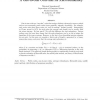Free Online Productivity Tools
i2Speak
i2Symbol
i2OCR
iTex2Img
iWeb2Print
iWeb2Shot
i2Type
iPdf2Split
iPdf2Merge
i2Bopomofo
i2Arabic
i2Style
i2Image
i2PDF
iLatex2Rtf
Sci2ools
TIT
2008
2008
A One-to-One Code and Its Anti-Redundancy
One-to-one codes are "one shot" codes that assign a distinct codeword to source symbols and are not necessarily prefix codes (more generally, uniquely decodable). For example, such codes arise when there exists an "end of message" channel symbol. Interestingly, as Wyner proved in 1972, for such codes the average code length can be smaller than the source entropy. By how much? We call this difference the anti-redundancy. Various authors over the years have shown that the anti-redundancy can be as big as minus the logarithm of the source entropy. However, to the best of our knowledge precise estimates do not exist. In this note, we consider a block code of length n generated by a binary memoryless source, and prove that the average anti-redundancy is 1 2 log2 n + C + F(n) + o(1) where C is a constant and either F(n) = 0 if log2(1 - p)/p is irrational (where p is the probability of generating a "0") or otherwise F(n) is a fluctuating function as the code len...
| Added | 15 Dec 2010 |
| Updated | 15 Dec 2010 |
| Type | Journal |
| Year | 2008 |
| Where | TIT |
| Authors | Wojciech Szpankowski |
Comments (0)

